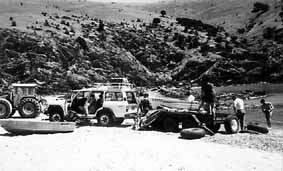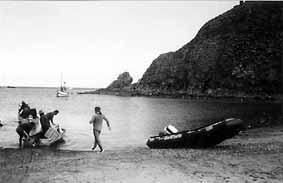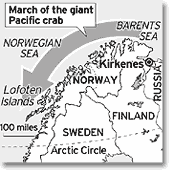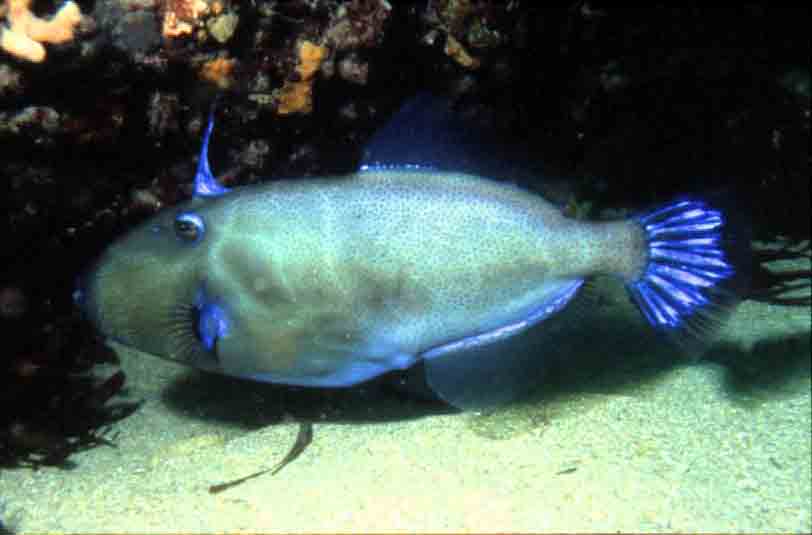Marine Life Society of South Australia Inc.
Newsletter
April 2004
No. 309"understanding, enjoying & caring for our oceans"
Next Meeting
The April meeting will be held at the Conservation Centre, 120 Wakefield Street, Adelaide on Wednesday 21st April commencing at 7.30pm.
Our speaker will be Greg Rouse from the SA Museum. His topic will be marine worms.
Contents
The Althorpes Island Group Visit
25th Anniversaries
A Ramble Over 26 Years Of Scuba Diving
Stalin's Last Army - Hordes Of Gigantic Crabs On Their Way To Invade Europe
Bluetails at RBJ
Contributors
This month our authors are Alex Gaut, Steve Reynolds, Julius Strauss and David Muirhead.
2004 Annual General meeting
This will be held on May 19th. As usual all Committee positions become vacant. Present Committee members can nominate themselves but anyone else who wishes to stand for any position will need a seconder. Nominations must be given to the Editor by 16th April for inclusion in the May Newsletter. This is in accordance with our Constitution. Nominations may NOT be made at the AGM for Committee positions, they must be advertised in the Newsletter.
Philip Hall - Editor
The Althorpes Island Group Visit
On 29th Feb. 2004, the second of what is now an annual expedition to explore a South Australian island group, began with great excitement at the Althorpes island group. The last trip was to the Nuyts group and next year it will be the Investigator/Sir Joseph Banks group.
The Althorpes are approximately 8 km SW of Innes National Park and can easily be seen from the mainland of the Yorke Peninsula. Althorpe Island has a long European history with its lighthouse keepers. The lighthouse was built in the late 1800’s and there are three lightkeeper cottages on the island, one for the family of each lightkeeper. In fact one of the main council members in the group actually grew up on the island because his father was a lightkeeper, then he became a lightkeeper and also worked on the island. There are many wrecks around the island that are well documented.
Althorpe Island Conservation Park has a very active Friends group who are very keen to have experts come and assess the island for conservation and heritage purposes. The group has undertaken huge vegetation mapping surveys of the island and has had grants for eradication of boxthorn and feral cats. Past experts to visit the island and write up reports include Graham Medlin, from the SA Museum, who examined the sub-fossils, and Ben Pavy a native vegetation expert from the Yorke Peninsula. I have also been to the island twice previously: once to assist in boxthorn eradication and once to undertake an amateur study of the intertidal organisms.
This trip, unlike the Nuyts, was solely marine research. The trip happened in two parts because there were so many interested people. Some stayed on the island, while most were on the RV Ngerin, the SARDI Aquatic Sciences research vessel. I only attended during the second ‘batch’ of the trip, but some like Scoresby Shepherd (MLSSA Patron) and Anthony Cheshire, Director of SARDI Aquatic Sciences, stayed the whole trip. Scoresby was so keen he even stayed on a few extra days on the island. The Ngerin was invaluable for transporting the large number of people and all their gear. However, at the other end the luxury was over. The famous ‘flying fox’, which had been used for decades for transporting large heavy goods to the top of the 90m tall island, had been decommissioned! We had to walk everything to the top of the island ourselves in stifling heat. It is a long and arduous path to the top of the island, where the cottages are so no one wanted to do more than one or two trips a day.
This trip included:
Graham Edgar, University of Tasmania and author of ‘Australian Marine Life’ and ‘Australian Marine Habitats’
Thierry Laperousaz, SA Museum, Collection Manager, Marine Invertebrates (non-Mollusca)
James Brooks, Reef Watch Project Officer
Brad Page, University of ?
Sue Gibbs,
Kirsten Benkendorff, Flinders University, Lecturer in Marine Biology
Dave ??, Melbourne Museum, Pycnogonid expert
Neville ??
Sue Murray-Jones, Coast & Marine Branch, DEH
Tim ??, District Ranger, Yorke/Mid North Region
Caroline Paterson, Senior Ranger, Innes National Park
The media came and produced a small news report on two channels. They stated that the trip included researchers from 4 states, 4 universities and 3 museums.
I was lucky enough to accompany Dr Kirsten Benkendorff, as a volunteer on my third trip to the island. Kirsten works on a number of different research topics associated with the biological and chemical ecology of intertidal molluscs (and we should get her to do a talk!). On this trip she was undertaking intertidal species surveys to compare the island with the mainland. My learning curve was pretty steep and I saw some mollusc eggs that I had not seen before and a pair of sea hares (Aplysia parvula) that I had only previously seen in Victoria.
Kirsten does an accumulated time series. She times the survey for one hour, but divided up into 6 sections of ten minutes each. She carries around a clipboard with about 6 sheets of species lists (including some common intertidal Echinoderms) on which she writes down in which time period she finds a species. For example, in the first ten minutes (period 1) she will usually find many species, in the second time period as they become harder to find, she should find a few less (each species only gets marked off once), by the time she gets to time period 6, the accumulation of species being found should level off and she often does not find any new species by this time. On rare occasions if she is still finding significant numbers of new species, then she will continue the survey into another ten-minute time period. At the very first survey site on the island, she had to continue the survey into another two time periods! Of all the surveys she did, the first site produced the highest number of species. The results of all the research from this trip will be published in a special edition of the Transactions of the Royal Society of South Australia.
Groups of organisms covered by the various researchers included: algae, molluscs, pycnogonids, fish, dolphins and seabirds.
The muttonbird research took place on the island, at night, and was a noisy and dirty affair. The birds migrate to and from the island every year, to breed there during the Australian summer. At this time of year the birds have fairly large chicks that the parents take turns to feed at night, while they hunt during the day. Brad Page was looking at their feeding habits but to do this had to flush the adult birds stomachs to make them regurgitate. He had at least 4-6 volunteers helping him every night. Muttonbirds dig burrows for their chicks, so the work involved lying down on the ground and putting your arm down a burrow to see who is home. Fortunately there are no snakes on the island! If you find an adult in the burrow, the technique is to get it to bite you then grab hold of its beak and pull. All birds were weighed, measured and flushed. This work continued every night from about 9 or 10 pm to about 1 or 2 am. There were lots of tired volunteers on the island!
It is hard work getting around the island. The cliffs are steep and Kirsten and I were like mountain goats for a couple of days on some very precarious paths. It wore us out a lot, so 2 surveys a day around low tide was plenty of work, followed, on the 2nd day by some snorkelling to relieve the high temperatures. The granite rocks at the base of the island were so hot that when sea spray hit them, steam rose off! A cool dip was a great relief. It was a lovely reef environment around the granite rock area, with profuse amounts of algae and some large fish, including the largest zebra fish I think I’ve ever seen! It reminded me how great the SA marine environment is.
One interesting thing we noticed, which Scoresby later confirmed, is that the limpet, Cellana solida, is on average very large on the island, compared with mainland specimens. Scoresby has noticed that many islands have much larger limpets than mainland populations, but nobody knows why.
On our last day, the ex-lightkeeper, John, took Kirsten, myself and two others out in a zodiac to see the NE and Eastern side of the island. On my previous trip, John actually rowed me around this same area and I took loads of pictures of the different intertidal zones with some lush algal communities. It is a lovely trip to do in a boat, as you get to see many otherwise inaccessible areas including getting close to Chain Island, where a New Zealand fur seal colony hauls out. On this trip there were not many animals around, perhaps less than fifty, compared with my previous trip when there must have been over a hundred. The seals had been popping up around the island to investigate all these people and kept a close eye on us. We had quite a few close encounters.
Kirsten and I stayed on in Innes National Park, with an honours student of hers, to complete a number of surveys with which to compare the island. I look forward to the results of Kirsten’s hard work. This was yet another fabulous trip and one that I believe was worthwhile for everyone involved. Keep an eye out for details of next year’s island research trip!
Alex Gaut
25th Anniversaries
Phill and Barb McPeake and Philip and Margaret Hall all joined our Society in April 1979. On the evening of our General Meeting on 21st April we will be acknowledging 25 years of membership by them all. By achieving 25 years of membership, Phill and Barb and Philip and Margaret more than double our list of 25th anniversary achievers. The list now comprises of Geoff Mower, Peter Gilbert, Steve Reynolds, Phill McPeake, Barb McPeake, Philip Hall and Margaret Hall. Congratulations to Phill, Barb, Philip and Margaret.
Steve Reynolds
A Ramble Over 26 Years Of Scuba Diving
I started scuba diving in January 1978 when I did a course through what was then called Lang’s Skindiving Service at Christies Beach. I completed my one test dive on 4th February 1978 and then joined the Marine Life Society (then MARIA) for a dive at the Bluff at Victor Harbor the next day. Whenever I re-visited the dive shop at Christies I would buy the latest issue of "Skindiving in Australia and New Zealand", a bi-monthly dive magazine. After hanging on to many of these issues for years I reluctantly disposed of them. Recently, however, I was doing a little research for which I needed to buy some early SIA (as we knew them) issues. One of these issues was dated March/April 1977 although I have reason to believe that it was actually the March/April 1979 issue.
I was surprised to find the following letter to the Editor in this issue: -
"Dear Barry (Andrewartha)
Have you ever tangled with a trigger fish and lost? This happened to me on a recent dive trip to Taveuni, Fiji in January with Allways Travel. The little monster was defending her jelly-like egg-mass nestled in a depression in the coral rubble, and judging by her repeated ferocious charges as I tried to sneak a photo, her young have every chance of reaching maturity unmolested by anything short of a ten metre white pointer!
However, this was the only time I lost my cool due to excellent organisation by Anthony Newly of Allways Tours* and by our dive hosts, Ric and Do Cammick, who did their utmost to ensure an unforgettable and surprisingly economical holiday both in and out of the water.
Teveuni is the garden island of Fiji, a title which applies as much to the coral reefs as to the island’s botany. Ric and Do, a New Zealand couple, have done tremendous work in furthering the future of skindiving in Fiji, having dived many of the seemingly countless and very accessible reefs around Taveuni with the help of the Le Lewai, their well equipped dive boat. Their task is made easier, of course, by the calm seas, remarkable visibility and warm water (78-80 °F).
If the reader gains the impression that Taveuni is an idyllic dive holiday, then this letter has achieved its purpose. Be assured, Australian divers will be hearing a lot more of Taveuni in the near future."
The letter was signed: - "Yours sincerely, David Muirhead" (our long-standing Committee Member and underwater photographer). It was written at least 25 years ago.
I checked through my latest copy of "Dive Log" where I found these two listings associated with resorts at Taveuni, Fiji.
Dive Taveuni Resort, divetaveuni@is.com.fj , www.newreach.com/divetaveuni .
Aqua-Trek Taveuni, Garden Island Resort, Mia & Kantoa Rimon, garden@connect.com.fj, www.aquatrek.com .
There is an advert for Allways Diving on page 77 of the February 2004 Dive Log. It suggests that Allways are celebrating their 25th anniversary (or over 25 years of operation) which seems to tie in with the fact that David’s letter was written over 25 years ago.
*The only reason for me rambling on about Allways now is so that I can tell another little story about David Muirhead.
The first time that I remember coming across David’s name was when he subscribed to the original MARIA Journals in the late 1970s. The next time that I came across David’s name was when I dived with members of the Fleurieu Scuba Club at the Aldinga Dropoff in February 1989. David and I were two of eight divers that day. I’m not sure of the procedures that day other than that we somehow did two dives. I did my two dives from two separate boats. David was my buddy on at least one of those dives and he may have signed my logbook. I can’t read the signature though. It may be a case of ‘doctor’s writing’. I remember that David used his underwater camera on the day. I dived with the same club again in April 1989 at Knato Inlet (?) near Cape Jervis. That day, however, most of the others were delayed at the Cape Jervis boat ramp and we passed them heading out when we were returning. I wonder how they got on because I seem to remember that the seas had become uncomfortable by that time. My next outing with the club was in November 1989 when we visited Kangaroo Island. We stayed at Middle River with Peter and Cate Telfer. I did four dives with David as my buddy and we shared a room at the homestead. I now realize that it was definitely David’s signature in my logbook. David always carried a camera on his dives.
I know that I’m really getting off of the track now but my logbook brings back so many great memories for me. We dived twice at Pissy Boy Rock (near Snug Cove), then once on the west side of Snug Cove and once at The Pinnacle near Snug Cove. We saw ever so many great fish, invertebrates and seals and dolphins. I caught a large cray for supper too. We also saw lots of great wildlife around Middle River. Peter Telfer was terrific as a tour guide. We did lots of diving, boating, four-wheel driving and walking. We also enjoyed a great barbecue tea finished off with my cray. Unfortunately, I overindulged and was ill during the night. Fortunately though, I was sharing with a GP. Now, the point of all my rambling is this – I think that it was on the next morning, whilst we were preparing the boat for the day’s diving, that we heard a report on the radio that said that Anthony Newly had died from the sting of a stingray (in Fiji?). I had heard of him but I remember David saying that he had met him. I think that David was in shock a little. Another sad part to this story is that just a few years later we heard that Peter Telfer had also died in his early 40s (not diving related).
It was the same day that we had heard about the death of Anthony Newly that David and I dived again at Pissy Boy Rock. This was the day that David took those now famous Leafy Seadragon with eggs photos. David was very intent on using most of his film on the Leafy which did its best to avoid David’s lens. The two of them were continually twisting around in mid-water. All I could do was watch or try to keep David in sight whilst I explored the area alone. At least I can always say that I was there with David when he took those fantastic photos.
I was there again when David entered his photos in an underwater photo competition and won lots of prizes (dive gear). I was also there with David at the Glenelg Blocks in January 1990 when David took photos of a Warty Prowfish on the sand. He used his Roleimarine (?) camera that day. That’s now over 14 years ago. By the time that you read this article, it will be over 15 years since I did my first dive with David, as far as I know. I had done earlier dives with the Fleurieu Scuba Club in 1988 but I only listed my actual buddies.
In finishing, I must mention that Sandy McKenzie, who was with David and I when we dived at the Aldinga Dropoff in 1989, died recently. It’s a sad note to finish on but it’s good to remember all those good times.
Steve Reynolds

Preparing the boats for the dive at Snug Cove, KI

Snug Cove at Kangaroo Island. David Batchelor is going to help fishermen to launch their dinghy.
Stalin's Last Army - Hordes Of Gigantic Crabs On Their Way To Invade Europe
Millions of giant Pacific crabs, whose ancestors were brought to Europe by Joseph Stalin in the 1930s, are marching south along Norway's coast, devouring everything in their path. The monster crabs, which can weigh up to 25lb and have a claw-span of more than three feet, are proving so resilient that scientists fear they could end up as far south as Gibraltar.

Energised by a mysterious population explosion a decade ago, whole armies of the crustaceans - known as the Kamchatka or Red King Crabs - have already advanced about 400 miles along the roof of Europe, overwhelming the ports of northern Norway.
They now number more than 10 million and have reached the Lofoten Islands off north-west Scandinavia, leaving in their wake what one expert described as "an underwater desert". In a graphic display of the extent of the crab’s submarine domination, some photographs of the ocean floor in Kirkenes in northern Norway show a writhing mass of the ugly, spiny animals.
Northern clams and other shellfish, once so numerous that divers could scoop up handfuls, have been all but eliminated.
Lars Petter Oie, a Norwegian diver who lives nearby, has seen the fjord outside his front door taken over by the crabs. Plunging through a hole in the ice, another diver surfaced within two minutes with a huge specimen. A snap of its claw is enough to remove a man's finger. Mr Oie said: "I have been to conferences on the crab and one thing the experts agree on is that they have rarely come across a species that is so adaptable. It can survive on almost anything: kelp, dead fish, seaweed and fish eggs. It even eats crushed shells to get the calcium it needs for its shell."
The relentless advance of the crabs has led to calls from some Norwegian marine experts for a government-subsidised "blitz" to try to halt their relentless march south. Andreas Tveteraas, an analyst in Oslo with the international World Wildlife Fund, said that urgent steps needed to be taken.
"This animal has no natural predators and it’s an alien species in the Barents Sea. That’s why its numbers are exploding. Some scientists say it will stay in the north because it likes the temperature but others think it can go as far south as Gibraltar."
For years the Norwegian government has ignored the underwater advance, undecided whether to treat the crabs as a resource or a pest. The animal’s legs are considered a delicacy and fetch top dollar in Japan and America. Even in Oslo, consumers pay around 200 Norwegian kronor (£15) a pound. Served with bread, butter, lemon and mayonnaise, the taste and texture of the crab meat is comparable with that of the finest lobster. One leg is enough to provide a grown man with a filling meal.
At present, some Norwegian fishermen have been granted seasonal licences to catch the Kamchatka crab but stiff regulations on the size of the boat used and other criteria mean they are few in number. Aasmund Bjordal, of the Department of Marine Resources in the western Norwegian town of Bergen, said: "We’re between two policies. One is to get rid of the crabs. The other is to manage it as a fishing resource. In the meantime, it’s already become an important source of income for some fishermen in the north. The problem is that it may be destroying the fishing stock."
Predicting the crab’s long-term effect on the marine ecology is difficult. The Barents Sea provides some of the world's richest fishing grounds and a collapse in stock would be a major disaster. There is some evidence that the crabs, which often live at great depths, have been eating the eggs of the caplin, a small fish that is a main source of food for cod.
In its native Pacific it faces much sterner competition but has nevertheless edged out other bottom-feeders to reach northern Japan and Vancouver Island. Transporting the monster crabs to the Barents Sea was originally part of a Stalinist era scheme to provide food for the populations in the north-western Soviet Union.
In the 1990s, for reasons nobody quite understands, the population exploded. In recognition of the growing threat to the local ecology, Norwegian authorities finally lifted on Jan 1 some of the restrictions on crabbing along part of the shoreline. As for the fishermen themselves, they are as deeply divided as the government.
Many Norwegian fishermen hate the crabs, blaming them for falling fish stocks and complaining that they get tangled in their nets. But for others, they have brought unprecedented wealth. At the Rallarn, a pub near the harbour, a fierce debate raged this week. Some favour annihilating the crabs, an almost impossible task, while others are tickled pink at the chance to gorge for free on a rare delicacy they find almost at the bottom of their gardens.
Elvis Jenssen, 41, said: "The bloody things hoover up everything off the bottom of the sea and all the fish are disappearing. They came over from Russia and now they’re taking over."
But Glenn, a 30-year-old car mechanic, replied: "It’s true the seabed now looks like the Sahara but they certainly taste good."
I saw a very large (probably the largest I’ve ever seen, and these are normally a big species anyway) Bluetail Leatherjacket under the T-junction at Rapid Bay Jetty on 26/2/04. This was a male. I think this is as far south as I’ve seen this species on the Fleurieu Peninsula. Other species on this dive included Mosaics, a single subadult Gunn’s, Yellowtails, Spinytails, Sixspines, Roughs, Pygmies, Horseshoes, Bridled and Bluelined (Gal’s), so this jetty is not surprisingly a haven for leatheries along with all those other common fishes.

David Muirhead